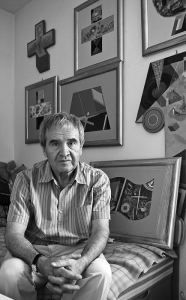 Branko Miljus ( 1963–2012) was born in 1936 in Dragotinja, Bosnia and Herzegovina, Republika Srpska. When he was three years old the family moved to Prijedor, just before the start of the Second World War. At the age of six he has experienced dramatic events during the escape to Kozara in 1943. In the same year he came to Belgrade with his mother and sister, where he attended elementary and high school. After the sixth year of high school (gymnasium) he enrolled at the Academy of Fine Arts in Belgrade, where he spent one year at the preparatory course, and then continued his studies in the Painting Department. He graduated in 1958 in the class of Nedeljko Gvozdenovic. He finished postgraduate studies at the Department of Graphics, in the class of Professor Bosko Karanovic.
Branko Miljus ( 1963–2012) was born in 1936 in Dragotinja, Bosnia and Herzegovina, Republika Srpska. When he was three years old the family moved to Prijedor, just before the start of the Second World War. At the age of six he has experienced dramatic events during the escape to Kozara in 1943. In the same year he came to Belgrade with his mother and sister, where he attended elementary and high school. After the sixth year of high school (gymnasium) he enrolled at the Academy of Fine Arts in Belgrade, where he spent one year at the preparatory course, and then continued his studies in the Painting Department. He graduated in 1958 in the class of Nedeljko Gvozdenovic. He finished postgraduate studies at the Department of Graphics, in the class of Professor Bosko Karanovic.
Miljus’s entry into the art scene was marked with a joint exhibition with Miodrag Nagorno and Radovan Kragulj in the Graphic Collective Gallery, 1959. In the same gallery, 1961, he gave his first solo exhibition. During 1962-1963, he specialized graphic in Paris studio of Gotthard Johnny Friedlaender, as a scholar of the French Government.
About Miljus’s firm artistic progress and a constant rise to the top of fine arts, testify awards that he received at best – known national and international art events: award for graphics at the October Salon (1960), the prize at the First International Exhibition ‘grafiek’ in Ljubljana (1961), the international award “Bianco e Nero” in Lugano (1962), “Politika’s” award for exhibition at the Museum of Contemporary art in Belgrade (1963), prize at the First International Biennial of Graphic Arts in Cracow (1967), first prize for the graphic on Third exhibition of Yugoslav portraits in Tuzla (1975), etc…
He began his very successful university career in 1972. when teaching council of the Academy of Fine Arts in Belgrade selected him as assistant for courses painting and drawing. At the same Academy, Miljus passed the elections in all three university teaching positions: Assistant professor for the course Graphics (1977), Associate professor (1982), Regular professor for Painting and Mural (1989). He also worked as a regular professor at the Academy of Fine Arts in Belgrade and the Graphics Department of the Academy of Arts in Banja Luka.
He was an active participant in many artistic associations. He worked as a vice president and member of the Arts Council of the Graphic Collective. He became a member of ULUS (Artist’s association of Serbia) in 1959. He was also a member of “Lada” and “Kunstlerhaus” International Association of Artists from Vienna (from 1999). As a painter of exceptional fertility and active performances he participated in many national and international art events.
He had more than sixty solo exhibitions at home and about sixty abroad and participated in about 250 group exhibitions. He has participated in numerous colonies and international symposia – Ecka, Ljubicevo, Sicevo, Yachting Club in Herceg Novi, colony Sreten Stojanovic in Prijedor etc.
Miljus’s works can be found in many famous domestic and foreign museums and galleries such as: National Museum in Belgrade, Museum of Contemporary Art in Belgrade, House of the Army of Serbia in Belgrade, Faculty of Dramatic Arts in Belgrade, Zepter Museum in Belgrade, Museum of Contemporary Art JAZU in Zagreb, Art Gallery of Bosnia and Herzegovina in Sarajevo, Gallery in Banja Luka, Museum of Kozara in Prijedor, Bolaffi-Legno collection in Turin, Dr. Gaetano D’Ambrosio in Treviso, Museum of Contemporary Art in Warsaw, National gallery in Prague, Historic art museum in Geneva, National Gallery in London, Victoria and Albert Museum in London, Museum of Lugano, Art Museum in Stockholm, Albertina in Vienna, Museum of Contemporary Art in Buenos Aires, Library of Congress in Washington, collection of the museum complex of imperial court in Kyoto, Japan, Cornell University – Ithaca in the USA , Juric Dimitrijevic collection in Florida, Museum of the University of South Florida – Tampa and many other private collections at home and abroad.
Branko Miljus remained versatile artist throughout his entire career – he engaged in painting, graphics, mosaics, stained glass, illustrations and graphic design. From the beginning, his work has been the focus of many domestic and foreign writers, art historians, art critics, journalists and all those who were involved in development process of Serbian and Yugoslav art.
Please enter Instagram username to display feed.
Follow @
